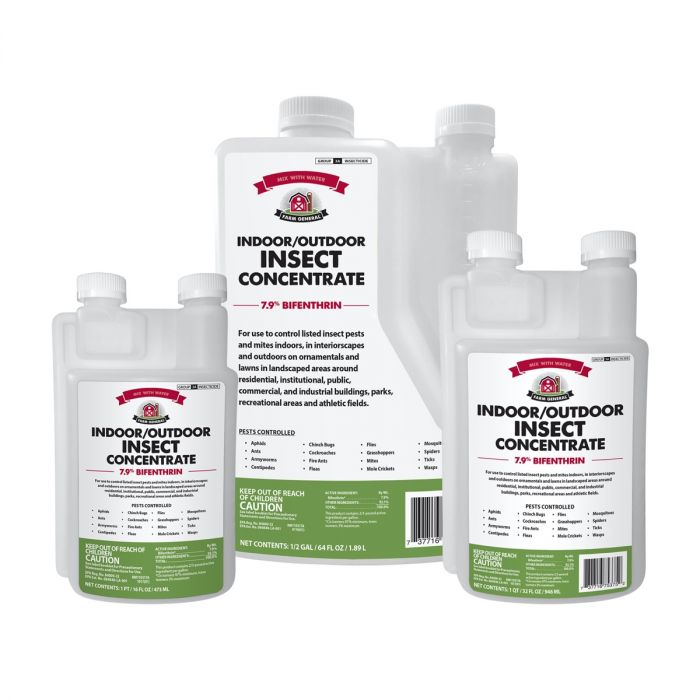Indoor/Outdoor Insecticide
We have the answer to the question you’ve been asking all season: “How do I kill [insert every kind of bug here]? It’s Farm General Indoor/Outdoor Insect Concentrate. This pesticide protects your home, business, parks, and landscape against invasive bugs that threaten your plants, your safety, and your hard work. Say goodbye to fire ants, flies, ticks, wasps, and a whole host of other creepy crawlies–and say hello to comfort and peace of mind.
Eliminate what bugs you
Farm General Indoor/Outdoor Insect Concentrate can be used around food/feed handling when mixed and used as directed. For a full list of targeted species and spraying instructions, please see the complete label.
Where to use:
Indoors or Outdoors on these Targeted Pests
| Ants | Flies | Bees | Millipedes |
| Beetles | Pillbugs | Boxelder Bugs | Scorpions |
| Silverfish | Centipedes | Sowbugs | Cockroaches |
| Spiders | Ticks | Crickets | Wasps |
| Earwigs | Firebrats |
When to use:
Use at the first sign of infestation or for general pest control.
Applying this product in calm weather when rain is not predicted for the next 24 hours will help to ensure that wind or rain does not blow or wash pesticide off the treatment area. See the complete label for timing of application specific to particular species of pests.
How to use:
For General Pest Control
Apply to areas where pests are likely to hide, paying close attention to crevices and cracks. Likely areas include baseboards, corners, storage areas, closets, and under appliances.
- Cockroaches, Crickets, Firebrats, Scorpions, Silverfish, Spiders, and Ticks: Apply as a coarse, low pressure spray to areas where these pests hide.
- Ants: Apply to trails, around doors and windows and other places where ants are visible.
- Bees and Wasps: Apply to nests late in the evening when insects are at rest. Thoroughly spray nest as well as its entrance and surrounding areas where insects alight.
- Boxelder Bugs, Centipedes, Earwigs, Beetles, Millipedes, Pillbugs, and Sowbugs: Apply around doors and windows and everywhere these pests may enter premises. Also spray baseboards and storage areas.
Each species of bugs behaves in unique ways and should be targeted accordingly. Please see complete label for application instructions for the bugs you are wishing to eliminate.
Precautions:
- Shake well before using and dilute according to the label (generally 1 fl oz to 1 gallon of water).
- Do not apply this product in a way that will make contact with food, people or pets, either directly or through drift. This pesticide is extremely toxic to fish and aquatic invertebrates.
- Only protected handlers may be in the area during application.
- Avoid contact with skin, eyes, or clothing. Do not breathe in spray mist.
- Reapply as needed, but no more than once a week.
Active Ingredients:
| Bifenthrin | 7.9% |
| Other Ingredients | 92.1% |
| Total | 100.0% |
Disclaimer:
It is a violation of Federal law to use this product in a manner inconsistent with its labeling. Read the entire label before each use. Use only according to label instructions.
See the complete label for specific use rates and detailed instructions.
Consult the Safety Data Sheet (SDS) for important safety information.

